new posts in all blogs
Viewing: Blog Posts Tagged with: translated picture books, Most Recent at Top [Help]
Results 1 - 10 of 10
How to use this Page
You are viewing the most recent posts tagged with the words: translated picture books in the JacketFlap blog reader. What is a tag? Think of a tag as a keyword or category label. Tags can both help you find posts on JacketFlap.com as well as provide an easy way for you to "remember" and classify posts for later recall. Try adding a tag yourself by clicking "Add a tag" below a post's header. Scroll down through the list of Recent Posts in the left column and click on a post title that sounds interesting. You can view all posts from a specific blog by clicking the Blog name in the right column, or you can click a 'More Posts from this Blog' link in any individual post.

By:
Betsy Bird,
on 12/11/2016
Blog:
A Fuse #8 Production
(
Login to Add to MyJacketFlap)
JacketFlap tags:
Best Books,
translations,
children's literature in translation,
translated picture books,
imports,
Best Books of 2016,
2016 imports,
2016 translated children's books,
31 days 31 lists,
Add a tag
 I know it gets confusing but this list is a bit different from the Calde-not list from a couple days ago. The reason is simple. While the Calde-not list looks primarily at books with illustrations so distinguished they could easily win major illustration awards if given half a chance, this is list is more for those books that may not blow you away on a first glance, but that make our publishing landscape richer for their very existence. I was inordinately pleased after I read each and every one of these books. They’re a little peculiar, distinctly different from what you’ll find in the American market, and altogether remarkable.
I know it gets confusing but this list is a bit different from the Calde-not list from a couple days ago. The reason is simple. While the Calde-not list looks primarily at books with illustrations so distinguished they could easily win major illustration awards if given half a chance, this is list is more for those books that may not blow you away on a first glance, but that make our publishing landscape richer for their very existence. I was inordinately pleased after I read each and every one of these books. They’re a little peculiar, distinctly different from what you’ll find in the American market, and altogether remarkable.
2016 International Imports for Kids
Picture Books
Chirri & Chirra by Yuki Kaneko

Sweet and dreamlike, this Japanese import has a light and sweetness to it that will simultaneously make it deeply beloved in a few select homes, while also not drawing so much attention to itself that it ever becomes much more than a cult hit in the States. Do yourself a favor and discover it. It’s the kind of book you want to influence the dreams of your children with.
Cry, Heart, But Never Break by Glenn Ringtved, ill. By Charlotte Pardi
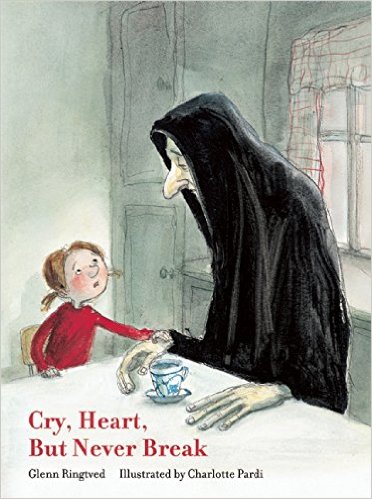
This Danish import just reminds us that when it comes to poetic picture books about death, American just don’t deal very well. Our death books tend to either be straightforward guides (here’s what to expect, etc.) or complete and utter fanciful metaphors. This book feels like it’s both fable and straightforward talk. A rare thing.
The Day I Became a Bird by Ingrid Chabbert, ill. Guridi

Kirkus didn’t get it. SLJ did. In this story a boy falls in love with a bird-loving girl. To get her attention he constructs an elaborate bird costume. Make of that what you will.
Don’t Cross the Line! by Bernardo P. Caravalho, ill. Isavel Martins

Portugal! And an interesting book at that. This one combines the interactive qualities of something like Don’t Let the Pigeon Drive the Bus or Press Here with a political statement about thwarting unjust authority. This book may get a bit more play in the coming years.
Look Up by Jung Jin-Ho

I love this one since it confronts and rearranges the reading experience and expectations of children. Add in the fact that it stars a girl in a wheelchair (who is not solely defined as a person from that chair) and you’ve got a golden book on your hands.
My Baby Crocodile by Gaetan Doremus
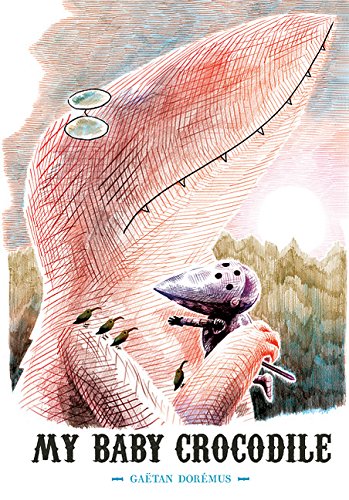
Funny story. I cannot read this book without setting it to the tune of “My Funny Valentine”. I suspect that this is because the two phrases share the same number of syllables more than anything else, but maybe it also has to do with the strange nature of love celebrated in this book. The story is between a near-sighted crocodile that “adopts” a knight, thinking he’s a baby croc. It’s odd and sweet and strange and funny. Memorable too.
A Promise Is a Promise by Knister, ill. Eve Tharlet

I found this one interesting perhaps because of the deep-seated feeling of betrayal our hero suffers in the course of things. It’s a very childlike understanding of an impossible promise and I like how it’s handled. A book that belies its cutesy cover.
Undercover by Bastien Contraire
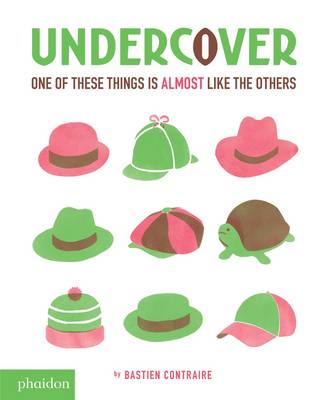
I absolutely adore this book. It’s a story where you have to spot the thing that doesn’t match. Contraire, living up to his name, doesn’t make it easy on you, though. The cover alone should be enough to prove that to you.
What Color Is the Wind? By Anne Herbauts
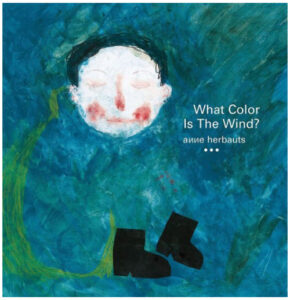
I’ve already reviewed it but if you somehow missed mention of this marvelous books about blindness and tactile response, now’s the time. You won’t find anything else like it on the market today.
Why Am I Here? by Constance Orbeck-Nilssen, ill. Akin Duzakin

Big questions for little brains. I like this one a lot. Lemur or not lemur.
Middle Grade
The Birth of Kitaro by Shigeru Mizuki

Honestly the backmatter explaining the entire history of the yokai in Japanese history and literature is some of the most fascinating stuff here. In a way, this book reads like what would have happened if Quasimodo turned into a superhero rather than a bell fantastic. I loved the peculiar (to me) nature of the storylines, the characters, and particularly the creatures.
The Heartless Troll by Oyvind Torseter
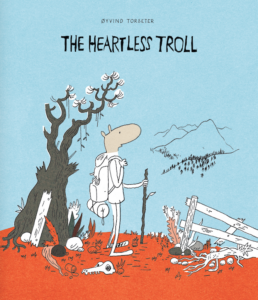
The troll is, without a doubt, one of the most horrific renderings I’ve seen in a children’s book in a long time. Which is to say – it’s awesome! Definitely hand this to older kids, but appreciate it on your own when you get a chance. As graphic novels go, there are few things to compare it to.
Under Earth / Under Water by Aleksandra Mizielinska and Daniel Mizielinski
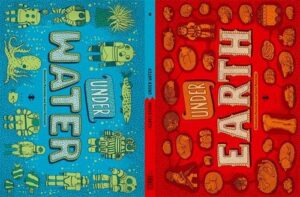
This Polish import is fantastic. There was a book of maps that came out from this couple previously. I’m not as big a fan of those, but what I am a fan of is learning about all that goes on below. Good times.
Misc
And just a quick shout-out to the Candied Plums titles that aren’t online yet. These are the real deal. I just adore them:
- Little Rabbit’s Questions by Dayong Gan, translated by Helen Wang (978194529270 – www.candiedplums.com)
- Picking Turnips by Xu Zhou, translated by Adam Lanphier (9781945295263 – www.candiedplums.com)
- Who Wants Candied Hawberries? by Dongni Bao, ill. Di Wu, translated by Adam Lanphier
Interested in the other lists of the month? Here’s the schedule so that you can keep checking back:
December 1 – Board Books
December 2 – Board Book Adaptations
December 3 – Nursery Rhymes
December 4 – Picture Book Readalouds
December 5 – Rhyming Picture Books
December 6 – Alphabet Books
December 7 – Funny Picture Books
December 8 – Calde-Nots
December 9 – Picture Book Reprints
December 10 – Math Picture Books
December 11 – Bilingual Books
December 12 – International Imports
December 13 – Books with a Message
December 14 – Fabulous Photography
December 15 – Fairy Tales / Folktales
December 16 – Oddest Books of the Year
December 17 – Older Picture Books
December 18 – Easy Books
December 19 – Early Chapter Books
December 20 – Graphic Novels
December 21 – Poetry
December 22 – Fictionalized Nonfiction
December 23 – American History
December 24 – Science & Nature Books
December 25 – Transcendent Holiday Titles
December 26 – Unique Biographies
December 27 – Nonfiction Picture Books
December 28 – Nonfiction Chapter Books
December 29 – Novel Reprints
December 30 – Novels
December 31 – Picture Books


By:
Betsy Bird,
on 10/11/2016
Blog:
A Fuse #8 Production
(
Login to Add to MyJacketFlap)
JacketFlap tags:
Reviews,
Best Books,
Anne Herbauts,
French children's books,
Enchanted Lion Books,
French picture books,
translated picture books,
international children's books,
Best Books of 2016,
2016 imports,
2016 picture books,
2016 reviews,
Reviews 2016,
2016 translated children's books,
Add a tag
 What Color Is the Wind?
What Color Is the Wind?
By Anne Herbauts
Translated by Claudia Zoe Bedrick
Enchanted Lion Books
$19.95
ISBN: 978-1-59270-221-3
Ages 5 and up
On shelves now
I’m going to have a hard time of it when my kids grow up. When I had them I swore up, down and sideways that I wouldn’t turn into the kind of blogger that declares that a book is good or bad, based solely on the whims of my impertinent offspring. For the most part, I’ve kept that promise. I review picture books outside of their influence, though I’m always interested in their opinions. Indeed, these opinions, and the sharp eyes that inform them, are sometimes not what I’d expect at all. So while I’ve never changed my opinion from liking a book to not liking it just because it didn’t suit my own particular kids’ tastes, I have admittedly found a new appreciation for other books when the children were able to spot things that I did not. What Color Is the Wind? is a pretty good example of this. I read the book at work, liked it fine, and brought it home for a possible review. My daughter then picked it up and proceeded to pretty much school me on what it contained, front to finish. Had I noticed the Braille on the cover? No. Did I see that the main character’s eyes are closed the whole time? No. How about the tactile pages? Did you notice that you can feel almost all of them? No. For a book that may look to some readers as too elegant and sophisticated to count as a favored bedtime story, think again. In this book Anne Herbauts proves beyond a shadow of a doubt that a distinct European style is engaging to American children when their parents give it half a chance. Particularly when tactile elements are involved.
 “We can’t see the wind, / we hear what it brings. / We can’t hear the wind, / we see what it brings.” The book begins with a question. A boy, his eyes closed, walks behind the cutout of a house. “What color is the wind? asks the little giant.” As he walks along, various plants, birds, animals, and inanimate objects offer answers. A wolf says the wind’s color is “the dark smell of the forest” while a window disagrees and says it’s “the color of time.” Everything that answers the little giant has a different feel on the page. The stream feels like consecutive ripples emanating from a dropped pebble, the roots of an apple tree like long, thin rivulets. At last the little giant encounters something that he senses is enormous. He asks his question and an enormous giant replies, “It is everything at once. This whole book.” He flips the book’s pages with his thumb so that they fly, and you the reader do the same, feeling the wind the book is capable of producing with its thick, lustrous pages. The color of the wind. The wind of this book.
“We can’t see the wind, / we hear what it brings. / We can’t hear the wind, / we see what it brings.” The book begins with a question. A boy, his eyes closed, walks behind the cutout of a house. “What color is the wind? asks the little giant.” As he walks along, various plants, birds, animals, and inanimate objects offer answers. A wolf says the wind’s color is “the dark smell of the forest” while a window disagrees and says it’s “the color of time.” Everything that answers the little giant has a different feel on the page. The stream feels like consecutive ripples emanating from a dropped pebble, the roots of an apple tree like long, thin rivulets. At last the little giant encounters something that he senses is enormous. He asks his question and an enormous giant replies, “It is everything at once. This whole book.” He flips the book’s pages with his thumb so that they fly, and you the reader do the same, feeling the wind the book is capable of producing with its thick, lustrous pages. The color of the wind. The wind of this book.
The Kirkus review journal said that this book was, “ ‘The blind men and the elephant’ reworked into a Zen koan” and then proceeded to recommend it for 9-11 year-olds and adults. I’m fairly certain I disagree with almost every part of that. Now here’s the funny part. I didn’t read this review before I read the book. I also didn’t read the press release that was sent to me with it. When I read a book I like to be surprised by it in some way. This is usually a good thing, but once in a while I can be a bit dense and miss the bigger picture. As I mentioned before, I completely missed the fact that this book was an answer to a blind child who had asked Anne Herbauts the titular question. I just thought it was cool that the book was so much fun to touch. Embossing, debossing, die-cuts, lamination, and all kinds of surfaces give the book the elements that make it really pop. As I read it in the lunchroom at work, my co-workers would peer over my shoulders to coo at what they saw. All well and good, but would a kid be interested too? Kirkus says they’d have to be at least nine to grasp its subtleties.
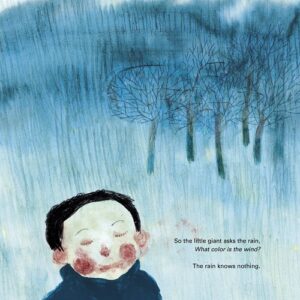 Obviously my 5-year-old daughter likes the book but she’s just one kid. She is not a representative for her species (so to speak). That said, this book just drills home the advantage that physical books have over their electronic counterparts: the sensation of touch. Play with a screen all day if you like, but you will never be able to move your fingers over these raised dots of rain or the rough bark of a tree’s trunk. As children become more immersed in the electronic, they become more enamored of tactile books. The sensation of paper on skin has yet to be replicated by our smooth as silk screens. And this will prove true with kids on the younger end of the scale. I’ll agree with Kirkus about the adult designation, though. When I worked for New York Public Library there was a group of special needs adults that would come in that were in need of tactile picture books. We would be asked if we had any on hand that we could hand over to them in some way. There were a few, but our holdings were pretty limited (though I do remember a particularly keen tactile version of The Very Hungry Caterpillar that proved to be a big hit). Those kids would have loved this book, but children of all ages, and all abilities, would feel the same way about it. Kids are never too old for tactile picture books. As such, you could use this book with Kindergartners as well as fifth graders. Little kids will like the fun pictures. Older kids may be inspired by the words as well.
Obviously my 5-year-old daughter likes the book but she’s just one kid. She is not a representative for her species (so to speak). That said, this book just drills home the advantage that physical books have over their electronic counterparts: the sensation of touch. Play with a screen all day if you like, but you will never be able to move your fingers over these raised dots of rain or the rough bark of a tree’s trunk. As children become more immersed in the electronic, they become more enamored of tactile books. The sensation of paper on skin has yet to be replicated by our smooth as silk screens. And this will prove true with kids on the younger end of the scale. I’ll agree with Kirkus about the adult designation, though. When I worked for New York Public Library there was a group of special needs adults that would come in that were in need of tactile picture books. We would be asked if we had any on hand that we could hand over to them in some way. There were a few, but our holdings were pretty limited (though I do remember a particularly keen tactile version of The Very Hungry Caterpillar that proved to be a big hit). Those kids would have loved this book, but children of all ages, and all abilities, would feel the same way about it. Kids are never too old for tactile picture books. As such, you could use this book with Kindergartners as well as fifth graders. Little kids will like the fun pictures. Older kids may be inspired by the words as well.
“Mom,” said my daughter as we went down the stairs for her post-reading, pre-brushing, nighttime snack. “Mom, you know the wind doesn’t have a color, right?” My child is a bit of a literalist. She’s the kid who knew early on that magic wasn’t real and once told me at the age of three that, “If ‘please’ is a magic word, it doesn’t exist.” So to read an entire book, based on the premise of seeing a color that couldn’t possibly be real, was a stretch for her. Remember, we read this entire book without really catching on that the little giant was blind. I countered that it was poetry, really. Colors were just as much about what they looked like as what they felt like. I asked her what blue made her feel, and red. Then I applied that to the emotions we feel about with the wind, which wasn’t really an analogy that held much water, but she was game to hear me out. “It’s poetry”, I said again. “Words that make you feel something when you read them.” So, as she had her snack, she had me read her some poetry. We’ve been reading poetry with her snack every night since. So for all that the book could be seen to be a straightforward picture book, to me it’s as much an introduction to poetry as anything else.
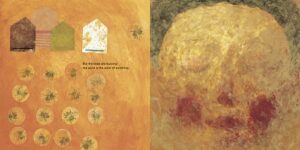
As for the art, I’ll admit that the combination of the style of art, the image on the cover, and the fact that the book is softcover and not hardcover (a cost-saving measure for what must be a very expensive title for Enchanted Lion Books to publish) did not immediately appeal to me. There’s no note to explain what the medium is and if I were to guess I’d say we were looking at crayons, mixed media, thick paints, colored pencils, ink blots, pen-and-inks, and more. Ironically, I really began to gravitate to the art when the little giant wasn’t stealing my focus. Nothing is intricately detailed, except perhaps the anatomy of honeybees or the raised and bumpy parts of the book. At the same time, for a book that celebrates touch, poetry, and physical sensation, the colors are often bright and lush. Whether it’s the blue watercolors of rain over trees or the hot orange that emanates from the page like a sun, Herbauts is simultaneously rendering illustrations obsolete with the unique format of What Color is the Wind? and celebrating their visual extremes.
I tend to give positive reviews to books that exceed my expectations. That’s just the nature of my occupation. And while I do believe that there are elements to this book that could be clearer or that there must have been a book jacket choice they could have chosen that was more appealing than the one you see here, otherwise I think this little book is a bit of a wonder. Deeply appealing to children of all ages, to say nothing of the adults out there, with so many uses, and so many applications. It reminds me of the old picture books by Bruno Munari that weren’t afraid to try new things with the picture book format. To get a little crazy. I don’t think we’ll suddenly see a big tactile picture book craze sweep the nation or anything, but maybe this book will inspire just one other publisher to try something a little different and to take a risk. Could be worth it. There’s nothing else like this book out there today. More’s the pity.
On shelves now.
Source: Final edition sent from publisher for review.
Like This? Then Try:
Professional Reviews:
Misc: A deeper look at some of the art over at Seven Impossible Things Before Breakfast

“If we don’t offer children literature from other languages, we are starving them.” Philip Pullman (TES, 2005)
 Phew! I’d been planning on doing a round-up of some of the speeches and talks I sat in on at the ALA Conference in Orlando a week or so ago, only to find that I’d lost my notes. They have since resurfaced.
Phew! I’d been planning on doing a round-up of some of the speeches and talks I sat in on at the ALA Conference in Orlando a week or so ago, only to find that I’d lost my notes. They have since resurfaced.
When one attends an ALA Conference in full, it is useful to decide early what kind of talks you’d like to attend. Is your interest in copyright or preservation? Do you have more of a yen to learn about sustainable thinking, coding groups, STEM collaboration, or small scale digitization? This year I decided to concentrate more on international children’s literature. It’s an interest that has grown within me over the past few years and I was curious to learn more about the topic.
First up, Diverse Books from Across the Globe. Description: “How can the local library help voices from emerging markets and developing countries be heard? How can we make their books available to refugee populations and foreign language speakers across the United States? Join innovators from Library for All to look at how libraries can continue to support access to quality educational materials in an increasingly global context.” The panelists included Rebecca McDonald of Library for All, Kerri Poore of First Book, and Hannah Ehrlich of Lee & Low Books.
This was right up my alley. As I say, my interest in international literature for kids has peaked over the last few years, possibly kickstarted by an event held at The New School in NYC that addressed American discomfort with books from other nations. With all the talk of getting kids to read more diverse books, there’s been very little talk about getting kids to read books that are from a diverse range of countries. Windows and mirrors are great, but why do the windows always have to look at our own back yards? Now with the rise of Donald Trump and the recent Brexit vote, nativism is at an all-time high, making me wonder why we don’t talk more about the value of teaching kids about other cultures through those nations’ books. I’m no innocent. I don’t think the world’s problems can be solved if kids in Texas read more books written for kids in Iraq. Nor do I think that American discomfort with the art of other nations (whether it’s foreign films or translated novels) is relegated solely to picture books. That said, there is value in learning, at a young age, the different ways in which other nations and cultures tell their stories.
 So! The talk! It was such an interesting collection of speakers. The focus of this particular panel was how to meet the needs of kids in the United States that have families from international cultures. I confess that I’d never heard of Library for All before. Though their primary purpose is to bring books to poverty stricken areas of the world, the organization also works closely with First Book to bring books from other countries to kids here in America. What struck me as particularly interesting is how they will essentially become book detectives for specific cultures and languages. Which is to say, they’ll go into other countries to seek out and find books that would otherwise never make it to American shores.
So! The talk! It was such an interesting collection of speakers. The focus of this particular panel was how to meet the needs of kids in the United States that have families from international cultures. I confess that I’d never heard of Library for All before. Though their primary purpose is to bring books to poverty stricken areas of the world, the organization also works closely with First Book to bring books from other countries to kids here in America. What struck me as particularly interesting is how they will essentially become book detectives for specific cultures and languages. Which is to say, they’ll go into other countries to seek out and find books that would otherwise never make it to American shores.
When it was time for questions I asked how librarians can work to promote international books here in the United States. There are some problems with doing so, of course. There is, and has always been, a marked preference for diverse American books vs. diverse international literature. Add in the fact that such books can only win a couple awards here and there, and there’s very little incentive on the part of the publishers to promote or distribute them.
In answering it was Hannah Ehrlich who gave me quite a lot to chew on. She pointed out to me (and this is key) that this isn’t just a children’s book problem. The wider difficulty comes with getting Americans as a whole used to different narrative styles. One way to do this is to get very young children used to these different kinds of books from the start.
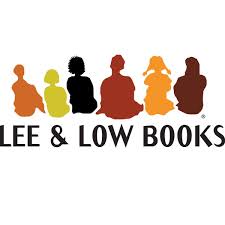 Another factor? The discoverability of international children’s book is key. Visibility is, in many ways, the greatest hurdle to overcome. That’s why we have USBBY lists like their yearly release of Outstanding International Books (you can find the 2016 list here). But the greatest hurdle? Getting such books into curriculum. To do this, publishers like Lee & Low work with the school and library market. The problem is that the text complexity of these books is often their downfall. Books written for foreign markets don’t care two bits about leveling. As a result, they’re often kept out of those schools that live and die by Fountas and Pinnell and their ilk.
Another factor? The discoverability of international children’s book is key. Visibility is, in many ways, the greatest hurdle to overcome. That’s why we have USBBY lists like their yearly release of Outstanding International Books (you can find the 2016 list here). But the greatest hurdle? Getting such books into curriculum. To do this, publishers like Lee & Low work with the school and library market. The problem is that the text complexity of these books is often their downfall. Books written for foreign markets don’t care two bits about leveling. As a result, they’re often kept out of those schools that live and die by Fountas and Pinnell and their ilk.
So what can be done? The panelists had some excellent suggestions. First off, let’s be honest. International children’s literature can sometimes be a hard sell. You can’t introduce these books to Americans cold. If you’re going to introduce a global perspective into your classroom, you need to foster a dialogue around these books. As for librarians, do displays of translated children’s books! Start international book clubs where you highlight a different country every month. And be aware that some types of books simply do not exist in other countries. Young adult literature, for example, just isn’t an age level designation in some places.
It was a good talk.
The second one I attended a little later was entitled Conversation Starter: Other People’s Voices: Using Global Literature in Translation to Reimagine Diversity in Libraries. Its panel consisted of Rachel Hildebrandt, Marc Aronson, and moderator Doris Gebel.
The problem? I had difficulty finding the room and missed Marc Aronson’s opening remarks. Too bad, since the man is a positive machine of good quotes. Here’s one I was able to catch:
“It is wrong to hem our children in to a national experience when they are living an international experience.”
Since the focus on this talk was, to a certain extent, translation, I was particularly intrigued by a mention made of something called The Global Literature in Libraries Initiative. In June there was an excellent piece in YALSA’s The Hub blog explaining what this is. As their mission statement says:
“. . . the Global Literature in Libraries Initiative strives to raise the visibility of world literature for adults and children at the local, national and international levels. We intend to do so by facilitating close and direct collaboration between translators and librarians, because we believe translators are uniquely positioned to help librarians provide support and events to engage readers of all ages in a library framework that explores and celebrates literature from around the world.”
There are a lot of great points in the piece. For example, when talking about the lack of international books available to a lot of kids today in our increasingly interconnected global world it said that, “Librarians play a key role in counteracting this dangerous insularity.”
 On the panel, the panelists mentioned that our love affair with translation is a funny, fickle thing. We do well when it comes to Pippi Longstocking, but we’re not great when it comes to contemporary literature. That gives the U.S. book market, and American children’s books in general, cultural dominance. To get an outsider perspective is invaluable to kids today. For example, in 2004 Chronicle Books won the Batchelder Award for The Man Who Went to the Far Side of the Moon: The Story of Apollo 11 Astronaut Michael Collins by Bea Uusma Schyffert, translated from the Swedish by Emi Guner. And let me tell you, our space program looks a LOT different when its story is told by someone other than rah-rah Americans.
On the panel, the panelists mentioned that our love affair with translation is a funny, fickle thing. We do well when it comes to Pippi Longstocking, but we’re not great when it comes to contemporary literature. That gives the U.S. book market, and American children’s books in general, cultural dominance. To get an outsider perspective is invaluable to kids today. For example, in 2004 Chronicle Books won the Batchelder Award for The Man Who Went to the Far Side of the Moon: The Story of Apollo 11 Astronaut Michael Collins by Bea Uusma Schyffert, translated from the Swedish by Emi Guner. And let me tell you, our space program looks a LOT different when its story is told by someone other than rah-rah Americans.
Doris Gebel urged the attendees to start kids young on international literature. Fail to do so and they won’t have a yearning for it as teens. Show them those “strange” books that confuse you, the adult. “Our young children need other books from other lands every day.”
Mention was made of the two major book lists/awards of translated children’s literature in the States. One is the Batchelder Award (named after Evanston librarian Mildred L. Batchelder so HOMETOWN PRIDE!) which is given each year. The International Books List (which I mentioned before) celebrates 40 books and breaks them down by age groups. That’s great, but the bulk of the books are from Western countries.
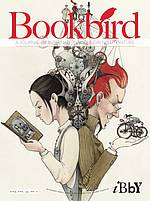 It was at this point that Marc Aronson spoke about the importance of distinctive translations. Take Anne Frank’s diary, for example. The version we read in schools is a very particular rendering. A lot of people would be shocked to hear that there are different versions out there. This reminded me of an article I read in Book Bird (a fantastic international children’s book periodical) years ago about how translating Hans Christian Andersen changes the meaning of his stories, depending on the translator. Until I read that piece it wasn’t something I’d thought about. As Marc said, “Translation is a creative act.” Mention was made at this time of the fact that for the very first time a woman has translated an edition of Madame Bovary. Meanwhile the famous translator of 100 Years of Solitude just died. If you think you know that book and you speak English, you only know his version.
It was at this point that Marc Aronson spoke about the importance of distinctive translations. Take Anne Frank’s diary, for example. The version we read in schools is a very particular rendering. A lot of people would be shocked to hear that there are different versions out there. This reminded me of an article I read in Book Bird (a fantastic international children’s book periodical) years ago about how translating Hans Christian Andersen changes the meaning of his stories, depending on the translator. Until I read that piece it wasn’t something I’d thought about. As Marc said, “Translation is a creative act.” Mention was made at this time of the fact that for the very first time a woman has translated an edition of Madame Bovary. Meanwhile the famous translator of 100 Years of Solitude just died. If you think you know that book and you speak English, you only know his version.
Today, things are perking up. In the last five years we’ve seen more small independent presses translating children’s books than ever before. Often these publishers are their own translators. Look at that USBBY list. It’s almost entirely small presses. And if these small presses don’t get reviewed in most of the journals out there (Kirkus is beloved to me because they take special care in reviewing the little guys) then the books just don’t get any attention.
When the audience members came up to speak, we heard some fascinating takes on all this. One woman said that the bulk of books translated from Colombia in the United States are about losing weight. She has Colombian immigrants in her library wondering aloud to her why Americans want them to lose weight so much, but that’s just what’s (weirdly) available.
So let’s talk solutions. What can libraries do to promote translated materials? Well, we could work with our immigrant communities more. Doris also pointed out that storytimes of translated books and library displays of translations could be useful as well. That got me to thinking how cool it would be if someone were to create lists like, “Top Ten Kids’ Books Translated from German” or “Top Ten Kids’ Books Translated from Swahili”. Or by country!
 Which finally brings us to the International Digital Children’s Library. If you haven’t seen it yet, please check it out. Seeking to serve the international community, the site makes, “the best in children’s literature available online free of charge.”
Which finally brings us to the International Digital Children’s Library. If you haven’t seen it yet, please check it out. Seeking to serve the international community, the site makes, “the best in children’s literature available online free of charge.”
Also mentioned was the collection at Worlds of Words, at the University of Arizona. The description reads, “Worlds of Words is committed to providing a range of resources to encourage educators at all levels to integrate global literature into the lives of children. The resources on this site grew out of work in schools around the world and the identification of needs…”
Thanks to both panels for this fascinating exchange of ideas. Much to chew on here.


By:
Betsy Bird,
on 3/10/2016
Blog:
A Fuse #8 Production
(
Login to Add to MyJacketFlap)
JacketFlap tags:
Reviews,
fairy tales,
Best Books,
Lisbeth Zwerger,
folk and fairy tale reviews,
German children's books,
minedition,
translated picture books,
Anthea Bell,
Best Books of 2016,
Reviews 2016,
2016 folk and fairytales,
2016 translated children's books,
Wilhelm Hauff,
Add a tag
 Dwarf Nose
Dwarf Nose
By Wilhelm Hauff
Illustrated by Lisbeth Zwerger
Translated by Anthea Bell
Minedition
$19.99
ISBN: 97898888341139
Ages 8-12
On shelves April 1st
It seems so funny to me that for all that our culture loves and adores fairytales, scant attention is paid to the ones that can rightfully be called both awesome and obscure. There is a perception out there that there are only so many fairytales out there that people really need to know. But for every Cinderella or Sleeping Beauty you run into, there’s a Tatterhood or Riquet with the Tuft lurking on the sidelines. Thirty or forty years ago you’d sometimes see these books given a life of their own front and center with imaginative picture book retellings. No longer. Folktales and fairytales are widely viewed by book publishers as a dying breed. A great gaping hole exists, and into it the smaller publishers of the world have sought to fulfill this need. Generally speaking they do a very good job of bringing world folktales to the American marketplace. Obscure European fairytales, however, are rare beasts. How thrilled I was then to discover the republication of Wilhelm Hauff and Lisbeth Zwerger’s Dwarf Nose. Originally released in America in 1995 by North-South books, the book has long been out-of-print. Now the publisher minedition has brought it back and what a beauty it is. Strange and sad and oddly uplifting, this tale has all the trappings of the fairytales you know and love, but somehow remains entirely unexpected just the same.
For there once was a boy who lived with his two adoring parents. His father was a cobbler and his mother sold vegetables and herbs in the market. One day the boy was assisting his mother when a very strange old woman came to them and starting digging her dirty old hands through their wares. Incensed, the boy insulted the old woman, which as you may imagine didn’t go down very well. When the boy is made to help carry the woman’s purchases back to her home he is turned almost immediately into a squirrel and made to work for seven years in her kitchen. After that time he awakes, as if in a dream, only to find seven years have passed and his body has been transformed. Now he has no neck to speak of, a short frame, a hunched back, and a extraordinarily long nose. Sad that his parents refuse to acknowledge him as their son, he sets forth to become the king’s cook. And all would have gone without incident had he not picked up that enchanted goose in the market one day. Written in 1827 this tale is famous in Germany but remains relatively obscure in the United States today.
 I go back and forth when I consider why this fairytale isn’t all that famous to Americans. There are a variety of reasons. There are some depressing elements to it (kid is unrecognizable to parents, loses seven years of his life, etc.) sure. There aren’t any beautiful princesses (except possibly the goose). The bad guy doesn’t even appear in the second act. Still, it’s the peculiarities that give it its flavor. We’ve heard of plenty of stories where the heroes are transformed by the villains, but how many villains give those same heroes a useful occupation in the process? It’s Dwarf Nose’s practicalities that are so interesting, as are the nitty gritty elements of the tale. I love the use of herbs particularly. Whether the story is talking about Sneezewell or Bellyheal, you get the distinct feeling that you’re listening to someone who knows what they’re talking about. Plus there are tiny rodent servants. That’s a plus.
I go back and forth when I consider why this fairytale isn’t all that famous to Americans. There are a variety of reasons. There are some depressing elements to it (kid is unrecognizable to parents, loses seven years of his life, etc.) sure. There aren’t any beautiful princesses (except possibly the goose). The bad guy doesn’t even appear in the second act. Still, it’s the peculiarities that give it its flavor. We’ve heard of plenty of stories where the heroes are transformed by the villains, but how many villains give those same heroes a useful occupation in the process? It’s Dwarf Nose’s practicalities that are so interesting, as are the nitty gritty elements of the tale. I love the use of herbs particularly. Whether the story is talking about Sneezewell or Bellyheal, you get the distinct feeling that you’re listening to someone who knows what they’re talking about. Plus there are tiny rodent servants. That’s a plus.
We like it when our fairytales give us nice clear-cut morals. Be clever, be kind, be good. This may be another reason why Dwarf Nose never really took off in the States. At first glance one would assume that the moral would be about not judging by appearances. Dwarf Nose’s parents cannot comprehend that their beautiful boy is now ugly, and so they throw him out. He gets a job as a chef but does not search out a remedy until the goose he rescues gives him some hope. I was fully prepared for him to remain under his spell for the rest of his life without regrets, but of course that doesn’t happen. He’s restored to his previous beauty, he returns to his parents who welcome him with open arms, and he doesn’t even marry the goose girl. Hauff ends with a brief mention of a silly war that occurred thanks to Dwarf Nose’s disappearance ending with the sentence, “Small causes, as we see, often have great consequences, and this is the story of Dwarf Nose.” That right there would be your moral then. Not an admonishment to avoid judging the outward appearance of a thing (though Dwarf Nose’s talents drill that one home pretty clearly) but instead that a little thing can lead to a great big thing.
 When this version of Dwarf Nose was originally released in the States in 1994 the reviews were puzzled by its length. Booklist said it was “somewhat verbose to modern listeners” and School Library Journal noted the “grotesque tenor of the book”. Fascinatingly this is not the only incarnation of this tale you might find in America. In 1960 Doris Orgel translated a version of “Dwarf Long-Nose” which was subsequently illustrated by Maurice Sendak. The School Library Journal review of Zwerger’s version in 1994 suggested that the Sendak book was infinitely more kid-friendly than hers. I think that’s true to a certain extent. You get a lot more pictures with the Sendak and the book itself is a much smaller format. While Zwerger excels in infinitely beautiful watercolors, Sendak’s pen and inks with just the slightest hint of orange for color are almost cartoonish in comparison. What I would argue then is that the intended age of the audience is different. Sure the text is remarkably similar, but in Zwerger’s hands this becomes a fairytale for kids comfortable with Narnia and Hogwarts. I remember as a tween sitting down with my family’s copy of World Tales by Idries Shah as well as other collected fairytales. Whether a readaloud for a fourth grade class, an individual tale for the kid obsessed with the fantastical, or bedtime reading for older ages, Dwarf Nose doesn’t go for the easy audience, but it does go for an existing one.
When this version of Dwarf Nose was originally released in the States in 1994 the reviews were puzzled by its length. Booklist said it was “somewhat verbose to modern listeners” and School Library Journal noted the “grotesque tenor of the book”. Fascinatingly this is not the only incarnation of this tale you might find in America. In 1960 Doris Orgel translated a version of “Dwarf Long-Nose” which was subsequently illustrated by Maurice Sendak. The School Library Journal review of Zwerger’s version in 1994 suggested that the Sendak book was infinitely more kid-friendly than hers. I think that’s true to a certain extent. You get a lot more pictures with the Sendak and the book itself is a much smaller format. While Zwerger excels in infinitely beautiful watercolors, Sendak’s pen and inks with just the slightest hint of orange for color are almost cartoonish in comparison. What I would argue then is that the intended age of the audience is different. Sure the text is remarkably similar, but in Zwerger’s hands this becomes a fairytale for kids comfortable with Narnia and Hogwarts. I remember as a tween sitting down with my family’s copy of World Tales by Idries Shah as well as other collected fairytales. Whether a readaloud for a fourth grade class, an individual tale for the kid obsessed with the fantastical, or bedtime reading for older ages, Dwarf Nose doesn’t go for the easy audience, but it does go for an existing one.
Lisbeth Zwerger is a fascinating illustrator with worldwide acclaim everywhere except, perhaps, America. It’s not that her art feels too “foreign” for U.S. palates, necessarily. I suspect that as with the concerns with the length of Dwarf Nose, Zwerger’s art is usually seen as too interstitial for this amount of text. We want more art! More Zwerger! I’ve read a fair number of her books over the years, so I was unprepared for some of the more surreal elements of this one. In one example the witch Herbwise is described as tottering in a peculiar fashion. “…it was as if she had wheels on her legs, and might tumble over any moment and fall flat on her face on the paving stones.” For this, Zwerger takes Hauff literally. Her witch is more puppet than woman, with legs like bicycle wheels and a face like a Venetian plague doctor. We have the slightly unnerving sensation that the book we are reading is, in fact, a performance put on for our enjoyment. That’s not a bad thing, but it is unexpected.
 When Zwerger’s Dwarf Nose came out in 1994 it was entering a market where folktales were on the outs. Still, libraries bought it widely. A search on WorldCat reveals that more than 500 libraries currently house in on their shelves after all these years. And while folktale sections of children’s rooms do have a tendency to fall into disuse, it is possible that the book has been reaching its audience consistently over the years. It may even be time for an upgrade. Though it won’t slot neatly into our general understanding of what a fairytale consists of, Dwarf Nose will find its home with like-minded fellows. Oddly touching.
When Zwerger’s Dwarf Nose came out in 1994 it was entering a market where folktales were on the outs. Still, libraries bought it widely. A search on WorldCat reveals that more than 500 libraries currently house in on their shelves after all these years. And while folktale sections of children’s rooms do have a tendency to fall into disuse, it is possible that the book has been reaching its audience consistently over the years. It may even be time for an upgrade. Though it won’t slot neatly into our general understanding of what a fairytale consists of, Dwarf Nose will find its home with like-minded fellows. Oddly touching.
On shelves April 1st.
Source: Galley sent from publisher for review.
Misc: Check out this fantastic review of the same book by 32 pages.


By:
Betsy Bird,
on 2/14/2016
Blog:
A Fuse #8 Production
(
Login to Add to MyJacketFlap)
JacketFlap tags:
issue picture books,
Julie Pearson,
Pajama Press,
translated picture books,
Reviews,
Canadian children's books,
Canadian picture books,
Manon Gauthier,
international children's books,
diverse picture books,
2016 picture books,
Reviews 2016,
Add a tag
 Elliot
Elliot
By Julie Pearson
Translated by Erin Woods
Illustrated by Manon Gauthier
Pajama Press
$16.95
ISBN: 978-1-927485-85-9
Ages 4-7
On shelves April 4th
The librarian and the bookseller face shelving challenges the like of which you wouldn’t believe. You think all picture books should simply be shelved in the picture book section by the author’s last name and that’s the end of it? Think again. If picture books served a single, solitary purpose that might well be the case. But picture books carry heavy burdens, far above and beyond their usual literacy needs. People use picture books for all sorts of reasons. There are picture books for high school graduates, for people to read aloud during wedding ceremonies, for funerals, and as wry adult jokes. On the children’s side, picture books can help parents and children navigate difficult subjects and topics. From potty training to racism, complicated historical moments and new ways of seeing the world, the picture book has proved to be an infinitely flexible object. The one purpose that is too little discussed but is its most complicated and complex use is when it needs to explain the inexplicable. Cancer. Absentee parents. Down syndrome. Explaining just one of these issues at a time is hard. Explaining two at one time? I’d say it was almost impossible. Julie Pearson’s book Elliot takes on that burden, attempting to explain both the foster system and children with emotional developmental difficulties at the same time. It works in some ways, and it doesn’t work in others, but when it comes to the attempt itself it is, quite possibly, heroic.
Elliot has a loving mother and father, that much we know. However, for whatever reason, Elliot’s parents have difficulty with their young son. When he cries, or yells, or misbehaves they have no idea how to handle these situations. So the social worker Thomas is called in and right away he sets up Elliot in a foster home. There, people understand Elliot’s needs. He goes home with his parents, after they learn how to take care of him, but fairly soon the trouble starts up again. This time Thomas takes Elliot to a new foster care home, and again he’s well tended. So much so that even though he loves his parents, he worries about going home with them. However, in time Thomas assures Elliot that his parents will never take care of him again. And then Thomas finds Elliot a ‘forever” home full of people who love AND understand how to take care of him. One he never has to leave.
 Let me say right here and now that this is the first picture book about the foster care system, in any form, that I have encountered. Middle grade fiction will occasionally touch on the issue, though rarely in any depth. Yet in spite of the fact that thousands and thousands of children go through the foster care system, books for them are nonexistent. Even “Elliot” is specific to only one kind of foster care situation (children with developmental issues). For children with parents who are out of the picture for other reasons, they may take some comfort in this book, but it’s pretty specific to its own situation. Pearson writes from a place of experience, and she’s writing for a very young audience, hence the comforting format of repetition (whether we’re seeing Elliot’s same problems over and over again, or the situation of entering one foster care home after another). Pearson tries to go for the Rule of Three, having Elliot stay with three different foster care families (the third being the family he ends up with). From a literary standpoint I understand why this was done, and I can see how it reflects an authentic experience, but it does seem strange to young readers. Because the families are never named, their only distinguishing characteristics appear to be the number of children in the families and the family pets. Otherwise they blur.
Let me say right here and now that this is the first picture book about the foster care system, in any form, that I have encountered. Middle grade fiction will occasionally touch on the issue, though rarely in any depth. Yet in spite of the fact that thousands and thousands of children go through the foster care system, books for them are nonexistent. Even “Elliot” is specific to only one kind of foster care situation (children with developmental issues). For children with parents who are out of the picture for other reasons, they may take some comfort in this book, but it’s pretty specific to its own situation. Pearson writes from a place of experience, and she’s writing for a very young audience, hence the comforting format of repetition (whether we’re seeing Elliot’s same problems over and over again, or the situation of entering one foster care home after another). Pearson tries to go for the Rule of Three, having Elliot stay with three different foster care families (the third being the family he ends up with). From a literary standpoint I understand why this was done, and I can see how it reflects an authentic experience, but it does seem strange to young readers. Because the families are never named, their only distinguishing characteristics appear to be the number of children in the families and the family pets. Otherwise they blur.
Pearson is attempting to make this accessible for young readers, so that means downplaying some of the story’s harsher aspects. We know that Elliot’s parents are incapable of learning how to take care of him. We are also assured that they love him, but we never know why they can’t shoulder their responsibilities. This makes the book appropriate for young readers, but to withdraw all blame on the parental side will add a layer of fear for those kids who encounter this book without some systematic prepping beforehand. It would be pretty easy for them to say, “Wait. I sometimes cry. I sometimes misbehave. Are my parents going to leave me with a strange family?”
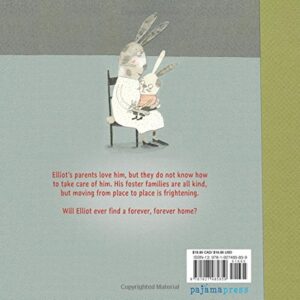 Artist Manon Gauthier is the illustrator behind this book and here she employs a very young, accessible style. Bunnies are, for whatever reason, the perfect animal stand-in for human problems and relationships, and so this serious subject matter is made younger on sight. With this in mind, the illustrator’s style brings with it at least one problematic issue. I suspect that many people that come to this book will approach it in much the same way that I did. My method of reading picture books is to grab a big bunch of them and carry them to my lunch table. Then I go through them and try to figure out which ones are delightful, which ones are terrible, and which ones are merely meh (that would be the bulk). I picked up Elliot and had the reaction to it that I’m sure a lot of people will. “Aw. What a cute little bunny book” thought I. It was around the time Elliot was taken from his family for the second time that I began to catch on to what I was reading. A fellow children’s librarian read the book and speculated that it was the choice of artist that was the problem. With its adorable bunny on the cover there is little indication of the very serious content inside. I’ve pondered this at length and in the end I’ve decided that it’s not the style of the art that’s problematic here but the choice of which image to show on the book jacket. Considering the subject matter, the publisher might have done better to go the The Day Leo Said, ‘I Hate You’ route. Which is to say, show a cover where there is a problem. On the back of the book is a picture of Elliot looking interested but wary on the lap of a motherly rabbit. Even that might have been sufficiently interesting to make readers take a close read of the plot description on the bookflap. It certainly couldn’t have hurt.
Artist Manon Gauthier is the illustrator behind this book and here she employs a very young, accessible style. Bunnies are, for whatever reason, the perfect animal stand-in for human problems and relationships, and so this serious subject matter is made younger on sight. With this in mind, the illustrator’s style brings with it at least one problematic issue. I suspect that many people that come to this book will approach it in much the same way that I did. My method of reading picture books is to grab a big bunch of them and carry them to my lunch table. Then I go through them and try to figure out which ones are delightful, which ones are terrible, and which ones are merely meh (that would be the bulk). I picked up Elliot and had the reaction to it that I’m sure a lot of people will. “Aw. What a cute little bunny book” thought I. It was around the time Elliot was taken from his family for the second time that I began to catch on to what I was reading. A fellow children’s librarian read the book and speculated that it was the choice of artist that was the problem. With its adorable bunny on the cover there is little indication of the very serious content inside. I’ve pondered this at length and in the end I’ve decided that it’s not the style of the art that’s problematic here but the choice of which image to show on the book jacket. Considering the subject matter, the publisher might have done better to go the The Day Leo Said, ‘I Hate You’ route. Which is to say, show a cover where there is a problem. On the back of the book is a picture of Elliot looking interested but wary on the lap of a motherly rabbit. Even that might have been sufficiently interesting to make readers take a close read of the plot description on the bookflap. It certainly couldn’t have hurt.
Could this book irreparably harm a child if they encountered it unawares? Short Answer: No. Long Answer: Not even slightly. But could they be disturbed by it? Sure could. I don’t think it would take much stretch of the imagination to figure that the child that encounters this book unawares without any context could be potentially frightened by what the book is implying. I’ll confess something to you, though. As I put this book out for review, my 4-year-old daughter spotted it. And, since it’s a picture book, she asked if I could read it to her. I had a moment then of hesitation. How do I give this book enough context before a read? But at last I decided to explain beforehand as much as I could about children with developmental disabilities and the foster care system. In some ways this talk boiled down to me explaining to her that some parents are unfit parents, a concept that until this time had been mercifully unfamiliar to her. After we read the book, her only real question was why Elliot had to go through so many foster care families, so we got to talk about that for a while It was a pretty valuable conversation and not one I would have had with her without the prompting of the book itself. So outside of children that have an immediate need of this title, there is a value to the contents.
What’s that old Ranganathan rule? Ah, yes. “Every book its reader.” Trouble is, sometimes the readers exist but the books don’t. Books like Elliot are exceedingly rare sometimes. I’d be the first to admit that Pearson and Gauthier’s book may bite off a bit more than it can chew, but it’s hardly a book built on the shaky foundation of mere good intentions. Elliot confronts issues few other titles would dare, and if it looks like one thing and ends up being another, that’s okay. There will certainly be parents that find themselves unexpectedly reading this to their kids at night only to discover partway through that this doesn’t follow the usual format or rules. It’s funny, strange, and sad but ultimately hopeful at its core. Social workers, teachers, and parents will find it one way or another, you may rest assured. For many libraries it will end up in the “Parenting” section. Not for everybody (what book is?) but a godsend to a certain few.
On shelves April 4th.
Source: Galley sent from publicist for review.


By:
Betsy Bird,
on 1/7/2016
Blog:
A Fuse #8 Production
(
Login to Add to MyJacketFlap)
JacketFlap tags:
Reviews,
Best Books,
funny picture books,
Sebastian Meschenmoser,
German children's books,
translated picture books,
NorthSouth Books,
German imports,
Best Books of 2016,
2016 imports,
2016 picture books,
2016 reviews,
Add a tag
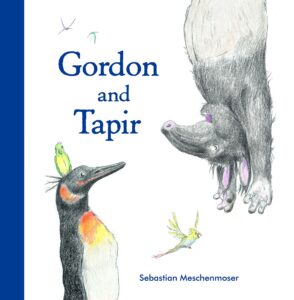 Gordon and Tapir
Gordon and Tapir
By Sebastian Meschenmoser
North/South Books
$18.95
ISBN: 9780735842199
Ages 3-6
On shelves April 1, 2016
There is a perception here in America about the Germans. It is a firm belief that, as a nation, they are devoid of a sense of humor. Americans love to bring this up. I’m not sure what they’re trying to prove necessarily when they say it, but the idea has been repeated so often that few would bother to contest it. Can you name any German stand-up comics? How about funny imported German films? What about funny German picture books? AH HA! There I’ve got you. Because while I cannot pull out of a hat any comics or movies, what I can do is show you without a sliver of a doubt that thanks to picture books like those of Sebastian Meschenmoser, we have absolute proof that Germans have a distinct and ribald sense of humor. With the release of his latest book in the States, Gordon and Tapir, Meschenmoser plumbs the Odd Couple concept with some distinctive twists of his very own. This is some primo German goofball stuff.
The book opens wordlessly. A penguin goes to his restroom with a newspaper. He reaches for the toilet paper. But what is this? Someone’s used it all up. And not just anyone. The penguin, who goes by the name of Gordon, stamps down the hall to his roommate Tapir’s room. Inside he finds the animal reclining in a toilet paper constructed hammock, an elaborate fruit cup in hand and a headdress that would wow Carmen Miranda on his noggin. Immediately Gordon launches into a litany of transgressions Tapir has engaged in. The floor’s sticky with fruit, the dishes are never done, and why exactly has there been a hippo living in the bathtub for the past few days? Tapir isn’t taking this lying down. He has his own complaints, like why does EVERYTHING have to be so neat and tidy? Why does the garbage have to stink of fish all the time? And why can’t Tapir join Gordon’s all-penguin club? Eventually, Gordon moves out and once Tapir discovers this he gives the bird a call. Turns out, it is a fantastic solution. Now Tapir can be dirty, Gordon can be neat, but they can visit each other and be friends again far better than if they lived together. Happy endings for all.
I’ve always carried the torch for Meschenmoser’s art. From his sleepless animals in Waiting for Winter to his previous penguin dip into surrealism in Learning to Fly the man has a strange kinship with the furry and feathery. So much of the character development in these tales comes from their body language. For example, there’s a spread in this book where Gordon lies in bed on his back staring at the ceiling at 3 a.m. while Tapir does much the same thing, albeit blearily, in his own room. This is followed by a silent film of sorts where Gordon finds a new place to stay in the paper and takes off as Tapir hears the door open and looks up with just the saddest expression in his eyes. Any picture book that dares to go silent for an extended amount of time in the center of the story is being gutsy. It’s not easy to pull off, and Meschenmoser ups the ante (as it were) by rendering everything during those wee hours of the morning in black and white graphite sketches.
 Then there are the little visual details and gags. The humor is sublime here. Meschenmoser is just as comfortable with silent gags (remember, this is coming from the man who made Charlie Chaplin references in the images of Mr. Squirrel and the Moon) as he is with words. Some of the jokes are there for the parents doing the reading. Did you notice the tapir in a bathing suit that bedecks the inside bathroom door? Or the fact that when Gordon stomps from the bathroom to Tapir’s room the wallpaper goes from a pristine fish pattern to paper that’s torn and peeling in large chunks? Did you see that the little cactus that Tapir gives to Gordon as a housewarming present is sitting on his dresser earlier in the book? And did you know that every single one of Gordon’s penguin friends is based on a famous author? I’ve good money riding on the fact that one of them resembles Sigmund Freud. I loved that Gordon has a goldfish swimming in his party drink (a tasty treat for later?). And so tiny you’d probably miss them but worth it every time I notice them is this: mongooses in teeny tiny colorful party hats. Life is sweeter because they are there.
Then there are the little visual details and gags. The humor is sublime here. Meschenmoser is just as comfortable with silent gags (remember, this is coming from the man who made Charlie Chaplin references in the images of Mr. Squirrel and the Moon) as he is with words. Some of the jokes are there for the parents doing the reading. Did you notice the tapir in a bathing suit that bedecks the inside bathroom door? Or the fact that when Gordon stomps from the bathroom to Tapir’s room the wallpaper goes from a pristine fish pattern to paper that’s torn and peeling in large chunks? Did you see that the little cactus that Tapir gives to Gordon as a housewarming present is sitting on his dresser earlier in the book? And did you know that every single one of Gordon’s penguin friends is based on a famous author? I’ve good money riding on the fact that one of them resembles Sigmund Freud. I loved that Gordon has a goldfish swimming in his party drink (a tasty treat for later?). And so tiny you’d probably miss them but worth it every time I notice them is this: mongooses in teeny tiny colorful party hats. Life is sweeter because they are there.
But for all that, the real reason I loved this book as much as I did was that the lesson I took away from it wasn’t American in the slightest. Imagine if a Yank tried writing the same book. Gordon and Tapir would have their differences. They’d have their fight. They’d both spend a sleepless night. Then the next morning Gordon would make a concession, Tapir would make a concession, and they’d work out their differences. And there is nothing wrong with a book about meeting someone halfway. Yet what I loved so much about this book was the fact that it eschewed every rote picture book plot I’d come to expect and went in an entirely new direction. Because honestly, let’s face it, sometimes friends are NOT meant to live together. Couples grow apart, people change, and there are times when you are much closer to someone if they don’t share the same space that you do 24/7. Meschenmoser makes it crystal clear that Gordon and Tapir’s friendship is stronger when Gordon leaves. Now I’m sure some folks will read this as a “stick with your own kind” narrative (after all, tapirs and penguins don’t even occupy the same temperate zones) but I’d argue that their friendship belies that. It isn’t that they don’t vastly enjoy each other’s company. They just need their own personal space at the end of the day, and that is absolutely 100% a-okay.
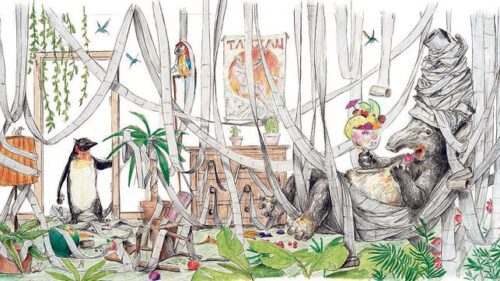 As crazy as it sounds, this actually wouldn’t be the worst picture book to hand to a small child with parents going through a divorce. I think it’s pretty clear from the book that sometimes you have nothing in common with the person you’re living with and that it’s best for all parties if a split is made. I don’t think the book was written with that intention in mind, and that is probably why it would work particularly well. There isn’t any didacticism to plow through. Just good storytelling
As crazy as it sounds, this actually wouldn’t be the worst picture book to hand to a small child with parents going through a divorce. I think it’s pretty clear from the book that sometimes you have nothing in common with the person you’re living with and that it’s best for all parties if a split is made. I don’t think the book was written with that intention in mind, and that is probably why it would work particularly well. There isn’t any didacticism to plow through. Just good storytelling
There’s a long history of funny German children’s literature that leads directly to Mr. Meschenmoser. Remember that this is the country where Der Struwwelpeter came to light (though its humor is a bit of an acquired taste). And alongside fellow contemporary funny German picture book artists like Torben Kuhlmann and Ole Konnecke he’s in good standing. With any luck we’ll be seeing more of their books coming to U.S. shores in the coming years. So who knows? Maybe if we get enough Gordon and Tapir types of books the humorless perception of the German people will undergo a change. At the very least, we’ll get some magnificent stories out of the deal. This one’s a keeper.
On shelves April 1st.
Source: Galley sent from publisher for review.
Like This? Then Try:


By:
Betsy Bird,
on 7/19/2012
Blog:
A Fuse #8 Production
(
Login to Add to MyJacketFlap)
JacketFlap tags:
Uncategorized,
picture book reviews,
Spanish picture books,
2012 picture books,
2012 reviews,
2012 translated children's books,
translated picture books,
Sonja Wimmer,
Cuento de Luz,
Jon Brokenbrow,
Add a tag
 The Word Collector
The Word Collector
By Sonja Wimmer
Translated by Jon Brokenbrow
Cuento de Luz
$14.95
ISBN: 978-8415241348
Ages 4-8
On shelves now
What is the ultimate goal of the picture book import? When someone takes the time to bring over and translate a work for children, they’re expecting that book to be able to say something universal. They want the book to be enjoyable to child readers regardless of nationality, which, when you sit down and think about it, is a pretty lofty goal. Yet this year I’ve been seeing some absolutely amazing translations in America for kids. From the Colombian Jimmy the Greatest to the Norwegian John Jensen Feels Different to the French My Dad Is Big and Strong, But . . . this has been an amazing year for international children’s literature. Now Spain enters the ring with La Coleccionista de Palabras or The Word Collector. A heady infusion of striking images and playful content, author/illustrator Sonja Wimmer brings us a fantastical tale that has something to say to us today, yesterday, and tomorrow as well.
What do you collect? Coins? Stamps? Stickers? Have you ever considered collecting words? Luna, the heroine of this little tale, does exactly that and the job fills her days. Whether they’re magic words or delicious words or humble words, pretty much if they are words she is interested. The trouble only comes the day that Luna reels in her nets to find just a paltry smattering of words, hardly enough to satisfy. It seems the people of the word just aren’t using the beautiful words out there anymore. So what’s a girl to do when the world grows forgetful? She packs her suitcase with every word in her arsenal and sets off to right a great wrong, that’s what.
 This is not a book for lazy people. It demands that you work at it. You can’t just sit back and have the text come to you as you flip through the pages. Some spreads seem fairly straightforward with the words traveling in a single straight line. Other times I felt like I was reading Bob Raczka’s Lemonade again, picking out the words and sentences where I could find them. Your first indication that this isn’t the usual fare comes on the fourth or fifth pages of the story. After reading that there was a girl named Luna who lived in the sky we encounter this luminous (most of the pages are luminous, by the way) image of a red haired child Madonna of sorts staring into a glass container of softly glowing letters like a kid with a firefly jar. When I first encountered
This is not a book for lazy people. It demands that you work at it. You can’t just sit back and have the text come to you as you flip through the pages. Some spreads seem fairly straightforward with the words traveling in a single straight line. Other times I felt like I was reading Bob Raczka’s Lemonade again, picking out the words and sentences where I could find them. Your first indication that this isn’t the usual fare comes on the fourth or fifth pages of the story. After reading that there was a girl named Luna who lived in the sky we encounter this luminous (most of the pages are luminous, by the way) image of a red haired child Madonna of sorts staring into a glass container of softly glowing letters like a kid with a firefly jar. When I first encountered

By:
Betsy Bird,
on 4/23/2012
Blog:
A Fuse #8 Production
(
Login to Add to MyJacketFlap)
JacketFlap tags:
picture book reviews,
Groundwood Books,
multicultural picture books,
Rafael Yockteng,
2012 picture books,
2012 reviews,
Best Books of 2012,
translated picture books,
Colombian picture books,
Elisa Amado,
House of Anansi Press,
Jairo Buitrago,
Latin American picture books,
Uncategorized,
Add a tag
 Jimmy the Greatest!
Jimmy the Greatest!
By Jairo Buitrago
Illustrated by Rafael Yockteng
Translated by Elisa Amado
Groundwood Books (House of Anansi Press)
$18.95
ISBN: 978-1-55498-178-6
Ages 4-8
On shelves now
Once in a while I’ll be impressed by a book for kids, pick it up to review it, and in the course of writing the review become more and more impressed as I return to the book for double, triple, quadruple looks. It hasn’t happened all that much lately. Usually it requires a special kind of title. So when I saw Jimmy the Greatest! a month or so ago I thought it might make for a good review thanks to its subject matter. It’s not like fun stories set in poor Latin America villages appear on my desk every day. I read it and enjoyed it but it wasn’t until I reread it, and reread it, and reread it, and reread it some more that the sheer brilliance of this little number got to me. With a careful hand author/illustrator pair Jairo Buitrago and Rafael Yockteng have created a book that is an ode to the people who stay in small communities, helping and improving the daily lives of their friends and neighbors. This is a story that folks can relate to, no matter where they live. It’s a paean to the heroes of small town life. Unsung heroes, I have located your book.
Jimmy’s fishing village is not particularly big or impressive since “there is usually only one small church and, if you’re lucky, a little gym where you can hit a punching bag, skip rope or box.” Boxing is precisely what Jimmy and all the other kids in the village spend a lot of their time doing, until one day Don Apolinar (who runs the gym) gives Jimmy a box containing books, magazines, and information about a guy named Muhammad Ali. Suddenly Jimmy starts using those glasses he never paid much attention to before and he’s reading everything he can get his hands on. In time, Don Apolinar leaves the village for the big city, but that’s okay. Jimmy stays behind, opening a little library and improving the boxing ring, and making the village a better place.
 I was discussing this book with a friend the other day and asked her, “Can you think of any other picture book where a character from a small town stays in that town to improve the lives of others?” She pointed out to me that while that may not happen in a lot of fictional picture books, it happens all the time in nonfiction ones. Of course usually in books like Planting the Trees of Kenya by Claire A. Nivola or She Sang Promise by Jan Godown Annino the hero goes away, gets some kind of training, then comes back to their village or tribe to improve life for others. The interesting thing about Jimmy the Greatest! is that our hero stays to make things better without ever having left himself. Yet what I liked about this was that the book doesn’t box Jimmy in. When he&rsq
I was discussing this book with a friend the other day and asked her, “Can you think of any other picture book where a character from a small town stays in that town to improve the lives of others?” She pointed out to me that while that may not happen in a lot of fictional picture books, it happens all the time in nonfiction ones. Of course usually in books like Planting the Trees of Kenya by Claire A. Nivola or She Sang Promise by Jan Godown Annino the hero goes away, gets some kind of training, then comes back to their village or tribe to improve life for others. The interesting thing about Jimmy the Greatest! is that our hero stays to make things better without ever having left himself. Yet what I liked about this was that the book doesn’t box Jimmy in. When he&rsq

By:
Betsy Bird,
on 3/27/2012
Blog:
A Fuse #8 Production
(
Login to Add to MyJacketFlap)
JacketFlap tags:
Uncategorized,
picture book reviews,
Coralie Saudo,
bedtime books,
Enchanted Lion Books,
French picture books,
subversive picture books,
2012 picture books,
2012 reviews,
Best Books of 2012,
translated picture books,
Kris Di Giacomo,
Add a tag
 My Dad Is Big and Strong, But…: A Bedtime Story
My Dad Is Big and Strong, But…: A Bedtime Story
By Coralie Saudo
Illustrated by Kris Di Giacomo
Translated by Claudia Zoe Bedrick
Enchanted Lion Books
$16.95
ISBN: 978-1-59270-122-3
Ages 4-8
On shelves April 17, 2012
Few picture book titles come with qualifications. More often than not they are statements of strong purpose. I Can Do It Too or No, I Want Daddy. Declarative books with forthright ideas and messages for the preschool set. That’s all well and good, but sometimes you want a book that entices you to pick through its pages from the title onward. Now there is no doubt that My Dad Is Big and Strong, But… is a work of translation. From the minute you look at it it has all the signs. The drawings are fun and eclectic but they feel strangely . . . European, perhaps? And the art inside is a mix of mixed media photographs and graphite. Then there’s the story, which doesn’t end with that kooky twist we Americans almost require in books of this sort these days. Finally there’s that title that seems to float in mid-air without direction. Yes, there is no doubt left in your mind that this is a French translation, but there is also no doubt that it is one of the most charming and engaging picture books to hike down the pike in years. A story that upsets expectations but retains its heart, this is the perfect bedtime fare for any kiddo that rejects the very notion of going to sleep (and who has a sense of humor).
Our hero’s dad has many fine and outstanding qualities. He is big. He is strong. But he does have one significant flaw that’s hard to overlook. Every night it’s the same old story. When bedtime rolls around he just adamantly refuses to go. The only thing to do is to start out by reading him some stories. After two he’ll demand another but his son is having none of it. It’s straight to bed and a game of waiting until the dad’s asleep (if the son tries to go to bed early he’ll just have to contend with a wide awake dad barging into his room anyway). Finally he seems to be asleep but just as the son attempts to turn out the life he hears, “No, don’t do that! Leave the light on!” Because while his dad may be big and strong he’s also a bit afraid of the dark.
There’s an entire subgenre of picture books out there where expectations are upended to the delight of the child reader. I can think of four books off the top of my head where a character is scared about the first day of school and then turns out to be a teacher (Back to School Tortoise] by Lucy M. George was the latest). And Amy Krouse Rosenthal went to town with the idea in Little Pea (a pea refuses to eat his dinner of candy), Little Hoot (an owl wants to go to bed while his parents insist he stay up all night), and

By:
Betsy Bird,
on 3/1/2012
Blog:
A Fuse #8 Production
(
Login to Add to MyJacketFlap)
JacketFlap tags:
Uncategorized,
Eerdmans Books for Young Readers,
translations,
children's literature in translation,
2012 picture books,
2012 reviews,
2012 translated children's books,
Don Bartlett,
Henrik Hovland,
Norwegian children's books,
Torill Kove,
translated picture books,
Add a tag
 John Jensen Feels Different
John Jensen Feels Different
By Henrik Hovland
Illustrated by Torill Kove
Translated by Don Bartlett
Eerdmans Books for Young Readers
$16.00
ISBN: 978-0-8028-5399-8
For ages 4-8
On shelves now
There is a lot to be said for a picture book book that is so unapologetically Norwegian that it ends up making you completely (not to mention unexpectedly) love it, regionalism and all. If you’ve ever encountered a large quantity of picture books from countries other than your own then you’ll know that tone is everything. Books in America tend to a have a distinctive flavor while books from other nations have another. Sometimes (often?) the two flavors don’t mix but once in a great while you end up with something like John Jensen Feels Different and everything’s okay again. A recent import, the book tackles the familiar theme of it’s-okay-to-be-different and gives it a bit of a twist. Understated and sly it’s a unique kind of book about a unique kind of guy. Funny and unfamiliar all at once, this is one case where the packaging matches the product.
John Jensen. He feels different. He feels it at home, on the bus, and at work. As we watch this perfectly amiable alligator (crocodile?) navigates through the realistic world of humans, holding down a good job as a tax consultant, we see him struggle with the idea. After much thought John decides that it’s his tail that makes him so very different from other people. Yet an attempt to tape it to his body only turns to pain when he sprains it after an accident. At the hospital he makes the acquaintance of Dr. Field (a nice elephant) who gives John the inspiring words he needs to stop being silly about his tail/who he is and to get on with his life.
I love the deadpan humor of it all. In fact the visual gags are such a perfect complement to the text that I was surprised to find that the author and illustrator weren’t one and the same. They must have consulted with one another heavily when creating the book. For example, I loved how artist Torill Kove portrayed John as a slightly sheepish reptilian office mate. There’s a great moment when he looks at a picture of fellow alligators, all of whom are his identical match, and he thinks, “Maybe I was adopted” followed by the book’s comment that “He doesn’t seem to look like anyone else in his family.” There were other little sly moments as well. I love that Dr. Field wears red sneakers. And I thought the endpapers were particularly keen. At the front of the book is the beginning of John tying his customary red bow tie and at the back is the rest of the process. It’s practically step by step.
 Then there’s the story itself. This is one of those books where the child readers squeal in frustration at the hero’s seeming stupidity. As John tries to figure out why exactly he’s different you can practically channel the voices of five-year-olds across the globe that scream, “He’s an alligator!!!” Of course, by not mentioning that John is an alligator (or is he a crocodile?) the book becomes an easy metaphor. By the way, the translation of the book is by one Don Bartlett. Let
Then there’s the story itself. This is one of those books where the child readers squeal in frustration at the hero’s seeming stupidity. As John tries to figure out why exactly he’s different you can practically channel the voices of five-year-olds across the globe that scream, “He’s an alligator!!!” Of course, by not mentioning that John is an alligator (or is he a crocodile?) the book becomes an easy metaphor. By the way, the translation of the book is by one Don Bartlett. Let
 I know it gets confusing but this list is a bit different from the Calde-not list from a couple days ago. The reason is simple. While the Calde-not list looks primarily at books with illustrations so distinguished they could easily win major illustration awards if given half a chance, this is list is more for those books that may not blow you away on a first glance, but that make our publishing landscape richer for their very existence. I was inordinately pleased after I read each and every one of these books. They’re a little peculiar, distinctly different from what you’ll find in the American market, and altogether remarkable.
I know it gets confusing but this list is a bit different from the Calde-not list from a couple days ago. The reason is simple. While the Calde-not list looks primarily at books with illustrations so distinguished they could easily win major illustration awards if given half a chance, this is list is more for those books that may not blow you away on a first glance, but that make our publishing landscape richer for their very existence. I was inordinately pleased after I read each and every one of these books. They’re a little peculiar, distinctly different from what you’ll find in the American market, and altogether remarkable.









































I’m actually delighted that you sometimes use your children as readers. Every now and then I read a bunch of reviews for a book that adults are enchanted by–maybe the illustrations remind them of books when they were younger, or a particular moral is being taught, or the artist is particularly sophisticated and original…I order the book, read it to children, and receive a universal, “Huh?”
Of course there are books that really only work for a few kids, but the universal “Huh?”–where not one hand goes up, asking to check it out–always makes me wish I had my money back. If I had my way, every picture book would be taken to a school or day-care center and tried on kids before it’s published.
Agreed. And it’s been a real blow to my reviews, in a way, that I don’t have daily interactions with large groups of children anymore. In lieu of that I had to make a couple of my own. Still, two is not a representative sample so I hold myself back on using them too too often.